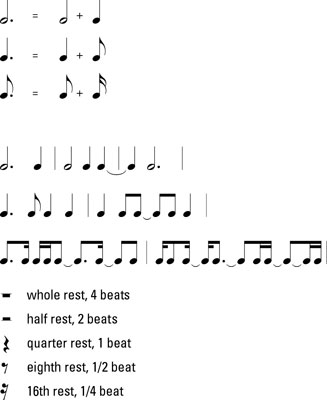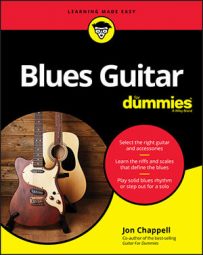After you develop a feel for different guitar strumming combinations, you can increase the rhythmic variations by learning how to apply syncopation to your guitar playing. Syncopation is the disruption or alteration of the expected rhythm of notes. In rhythmic guitar playing, you can apply syncopation by staggering your strum and mixing up your up- and downstrokes to strike different parts of the beats. By doing so, you let the agents of syncopation — dots, ties, and rests — steer your rhythmic strumming to a more dramatic and interesting course.
A dot attached to a note increases its rhythmic value by half the original length. So a dot attached to a half note (two beats) makes it three beats long. A dotted quarter note is one and a half beats long, or the total of a quarter note plus an eighth note.
A tie is a curved line that connects two notes of the same pitch. The value of the tied note adds to the original, so that only the first note is sounded, but the note is held for the duration of the two notes added together.

So how do dots and ties actually make syncopation in a musical context? Here are two example progressions — one in a straight-eighth feel and another in a shuffle — that you can practice playing. They both have common syncopation figures used in the blues.
Straight-eighth-note feel syncopation: The use of dots and ties signals a syncopated rhythm. If the tied figures present a problem, practice the figure by first ignoring the ties (in other words, play the tied note). Then, later, skip over the tied notes and hold out the first note of the tie for the entire length.
 A straight-eighth progression in A that uses common syncopation figures.
A straight-eighth progression in A that uses common syncopation figures.Shuffle feel syncopation: A shuffle rhythm divides the quarter note into two eighth notes, but the first eighth note is held longer than the second, producing a swinging, lilting feel.
 A shuffle in A that uses common syncopation figures.
A shuffle in A that uses common syncopation figures.Although the same syncopation scheme appears here as the previous example, notice how the shuffle feel makes it fall in a slightly different place in the beat.

